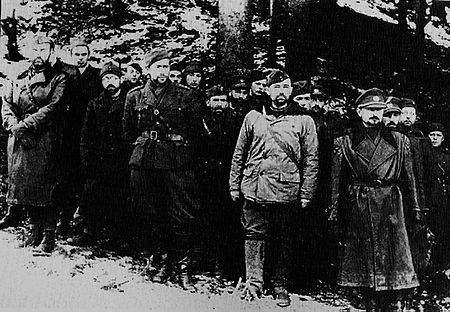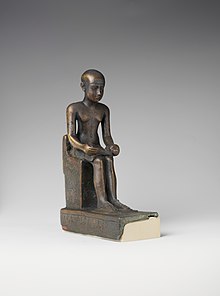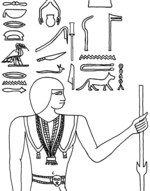Imhotep
| ||||||||||||||||||||||||||||||||||||||||||||||||||||
Read other articles:

此條目需要补充更多来源。 (2021年7月4日)请协助補充多方面可靠来源以改善这篇条目,无法查证的内容可能會因為异议提出而被移除。致使用者:请搜索一下条目的标题(来源搜索:美国众议院 — 网页、新闻、书籍、学术、图像),以检查网络上是否存在该主题的更多可靠来源(判定指引)。 美國眾議院 United States House of Representatives第118届美国国会众议院徽章 众议院旗帜…

Radio station in Marlin, TexasKRMXMarlin, TexasBroadcast areaWaco, TexasFrequency92.9 MHzBranding92.9 Shooter FMProgrammingFormatCountryOwnershipOwnerM&M Broadcasters, LTD.(Gary Moss)Sister stationsKBHT, KRQX, KWBT, KRZIHistoryFirst air date1977 (as Class A KLMT @ 96.7 MHz)Former call signsKLMT (1977–1987)KRXX (1987–1990)KEYR (1990–1999)KLRK (1999–2010)Technical informationFacility ID35581ClassC2ERP50,000 wattsHAAT150 meters (490 ft)Transmitter coordinates31°24′45.00″N 97°…

جزء من سلسلة مقالات سياسة ألبانيارومانيا الدستور الدستور حقوق الإنسان السلطة التنفيذية الرئيس مجلس الوزراء السلطة التشريعية البرلمان السلطة القضائية القضاء الانتخابات الانتخابات الأحزاب السياسية التقسيم الاداري الوحدات الإقليمية أقاليم مدن السياسة الخارجية العلاقات ا…

Questa voce sull'argomento teatri di Roma è solo un abbozzo. Contribuisci a migliorarla secondo le convenzioni di Wikipedia. Teatro Beat '72UbicazioneStato Italia LocalitàRoma Modifica dati su Wikidata · ManualeCoordinate: 41°53′36.74″N 12°30′01.87″E / 41.893539°N 12.500519°E41.893539; 12.500519 Pianta originale del Teatro Beat '72 Il Beat '72 fu uno dei primi centri teatrali di ricerca dedicato al teatro e alla poesia e ad altre rappresentazioni art…

本表是動態列表,或許永遠不會完結。歡迎您參考可靠來源來查漏補缺。 潛伏於中華民國國軍中的中共間諜列表收錄根據公開資料來源,曾潛伏於中華民國國軍、被中國共產黨聲稱或承認,或者遭中華民國政府調查審判,為中華人民共和國和中國人民解放軍進行間諜行為的人物。以下列表以現今可查知時間為準,正確的間諜活動或洩漏機密時間可能早於或晚於以下所歸類�…

Jeanne CarpenterLantern bersama Jeanne Carpenter dan Clara Kimball Young di What No Man Knows (1921)LahirTheo-Alice Jeanne Carpenter(1917-02-01)1 Februari 1917Kansas City, Missouri, ASMeninggal5 Januari 1994(1994-01-05) (umur 76)Oxnard, California, ASPekerjaanActressTahun aktif1919-1945Suami/istriRobert Drysdale (1937 - 1947)Robert Alvin Grimes (July 13, 1949 - January 5, 1994)Anak5 Theo-Alice Jeanne Carpenter (1 Februari 1917 – 5 Januari 1994)[1][2] ada…

Кружевной узел (−2,3,7)[англ.] имеет две правосторонние скрутки в первом плетении[англ.], три левосторонние скрутки во втором и семь левосторонних скруток в третьем. В теории узлов кружевное зацепление (или крендельное зацепление) — это специальный вид зацепления. Кружевн�…

HamptonStasiun komuter PTVLokasiRailway Crescent, HamptonMelbourne, VictoriaAustraliaPemilikVicTrackOperatorMetro TrainsJalur SandringhamJumlah peron2 sisiJumlah jalur2LayananBusKonstruksiJenis strukturTanahParkir170Informasi lainZona tarifMyki Zona 2Situs webPublic Transport VictoriaElektrifikasiYaOperasi layanan Stasiun sebelumnya Metro Trains Stasiun berikutnya Brighton Beachmenuju Flinders Street Jalur SandringhamSandringhamTerminus Sunting kotak info • L …

JesaNama KoreaHangul제사 Hanja祭祀 Alih AksarajesaMcCune–Reischauerchesa Jesa adalah upacara yang dipraktikkan di Korea untuk memperingati hari kematian leluhur di sebuah keluarga. Jenis ritual Ada beberapa jenis ritual yang diadakan seperti gijesa (기제사), charye (차례), seongmyo (성묘), myosa (묘사). Gijesa adalah upacara yang dilakukan pada peringatan hari kematian leluhur setiap tahunnya. Gijesa diadakan untuk memberikan persembahan bagi 4 generasi nenek moyang terdahulu di r…

Fighters in the Slovak resistance movementStanislav Rejthar [cs] (light jacket) of the Slovak Insurgent Air Force with officers and men of the 2nd Czechoslovak Partisan Brigade Slovak partisans were fighters in irregular military groups participating in the Slovak resistance movement, including against Nazi Germany and collaborationism during World War II. Beginning 18th Anti Aircraft Artillery Battery, which took part in the Slovak National Uprising of Autumn 1944 Slovak partisans …

Stephen Smith Menteri PertahananMasa jabatan13 September 2010 – 18 September 2013Perdana MenteriJulia GillardKevin RuddPendahuluJohn FaulknerPenggantiDavid JohnstonMenteri PerdaganganMasa jabatan28 Juni 2010 – 13 September 2010Perdana MenteriJulia GillardPendahuluSimon CreanPenggantiCraig EmersonMenteri Urusan Luar NegeriMasa jabatan3 Desember 2007 – 13 September 2010Perdana MenteriKevin RuddJulia GillardPendahuluAlexander DownerPenggantiKevin RuddAnggota Parleme…

Australian politician For other people named Thomas Paterson, see Thomas Paterson (disambiguation). The HonourableThomas PatersonDeputy Leader of the Country PartyIn office19 November 1929 – 27 November 1937LeaderEarle PagePreceded byWilliam GibsonSucceeded byHarold ThorbyMinister for the InteriorIn office9 November 1934 – 29 November 1937Prime MinisterJoseph LyonsPreceded byEric HarrisonSucceeded byJohn McEwenMinister for Markets and TransportIn office10 December 1928 …

This article needs to be updated. The reason given is: Official results needed.. Please help update this article to reflect recent events or newly available information. (February 2017) 2016–17 Haitian Senate election ← 2015-16 20 November 2016 (first round)29 January 2017 (second round) Next → Party Leader % Seats +/– PHTK 6 Plateforme Vérité 3 KID 3 OPL 1 FL 1 AAA 1 Pont 1 PPD 1 LIDE 1 This lists parties that won seats. See the complete results below.Politics of Hai…

Deliberate infliction of suffering on a person For other uses, see Torture (disambiguation). Captured Viet Cong soldier, blindfolded and tied in a stress position by American forces during the Vietnam War, 1967. Torture is the deliberate infliction of severe pain or suffering on a person for various reasons, including punishment, extracting a confession, interrogation for information, or intimidating third parties. Some definitions are restricted to acts carried out by the state, but others incl…

وادي مظللة تقسيم إداري البلد السعودية معلومات أخرى منطقة زمنية ت ع م+03:00 تعديل مصدري - تعديل وادي مظللة قرية سعودية، تتبع مركز السديره التابعة لمحافظة الطائف في منطقة مكة المكرمة. تقع في جنوب شرق الطائف، وتبعد عنها قرابة 40 كم. يوجد في القرية مركز صحي مظللة.[1] �…

Sebuah plastik yang terbuat dari selofan. Selofan adalah selulosa yang trasnparan. Namanya berasal dari kata cello dan phane yang merupakan singkatan dari bahasa Prancis yaitu cellulose dan diaphane dengan arti yang sama.[1] Selofan mempunyai sifat fisika yang transparan, sangat terang, dan bukan termoplastik. Sifta kimianya adalah tidak larut dalam air atau minyak. Sedangkan sifat mekanisnya adalah mudah retak pada kelembaban dan suhu rendah, mudah dilaminasi, mudah robek saat tertusuk …

Questa voce sull'argomento politici italiani è solo un abbozzo. Contribuisci a migliorarla secondo le convenzioni di Wikipedia. Segui i suggerimenti del progetto di riferimento. Amor Tartufoli Senatore della Repubblica ItalianaDurata mandato8 maggio 1948 –11 maggio 1963 LegislaturaI, II, III, IV Gruppoparlamentaredemocristiano CircoscrizioneMarche CollegioAscoli Piceno Incarichi parlamentari I legislatura: Commissione speciale ddl opere pubbliche: Membro da…

Git Gay Git Gay. Fotograf: Louis Huch.FöddBirgit Agda Holmberg13 juli 1921Karlshamn, SverigeDöd1 juli 2007 (85 år)Malmö, SverigeNationalitetSvenskYrke/uppdragRevyartist, skådespelerska, sångerskaMakeArne Hildén (1945–1948; skilda) Stig Svanberg (1948–1953; skilda) Lennart Carp (1953–1991; hans död) Git Gay, 1960. Git Gay, egentligen Birgit Agda Carp,[1] född Holmberg den 13 juli 1921 i Karlshamn, död 1 juli 2007 i Malmö,[2] var en svensk revyartist, skådespelare och sånge…

ميّز عن بطاطا حلوة. اضغط هنا للاطلاع على كيفية قراءة التصنيف البطاطا أصناف مختلفة من البطاطا المرتبة التصنيفية نوع[1] التصنيف العلمي النطاق: حقيقيات النوى المملكة: النباتات الشعبة: مستورات البذور الطائفة: ثنائيات الفلقة الرتبة: الباذنجانيات الفصيلة: الباذنجان�…




